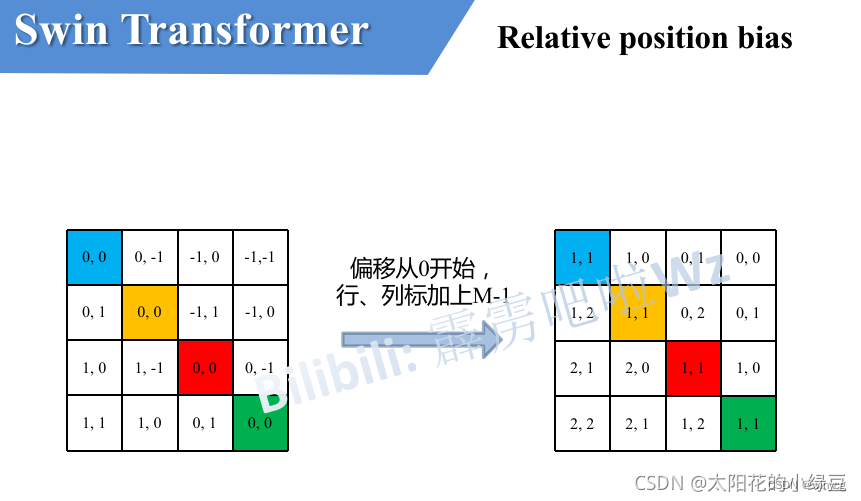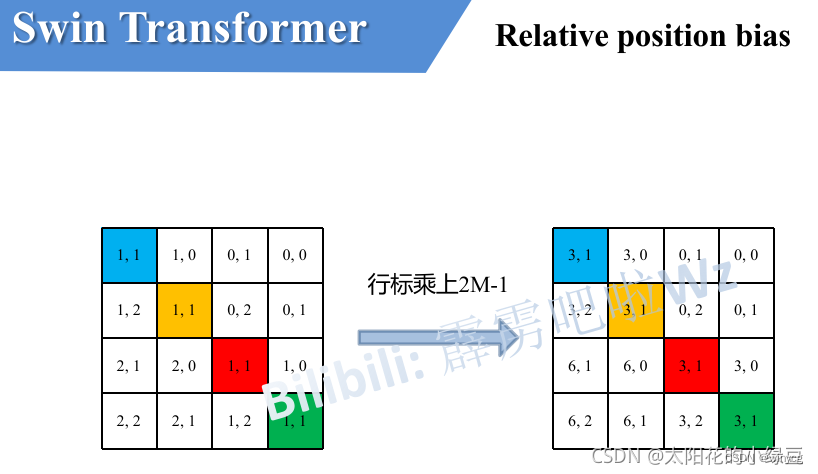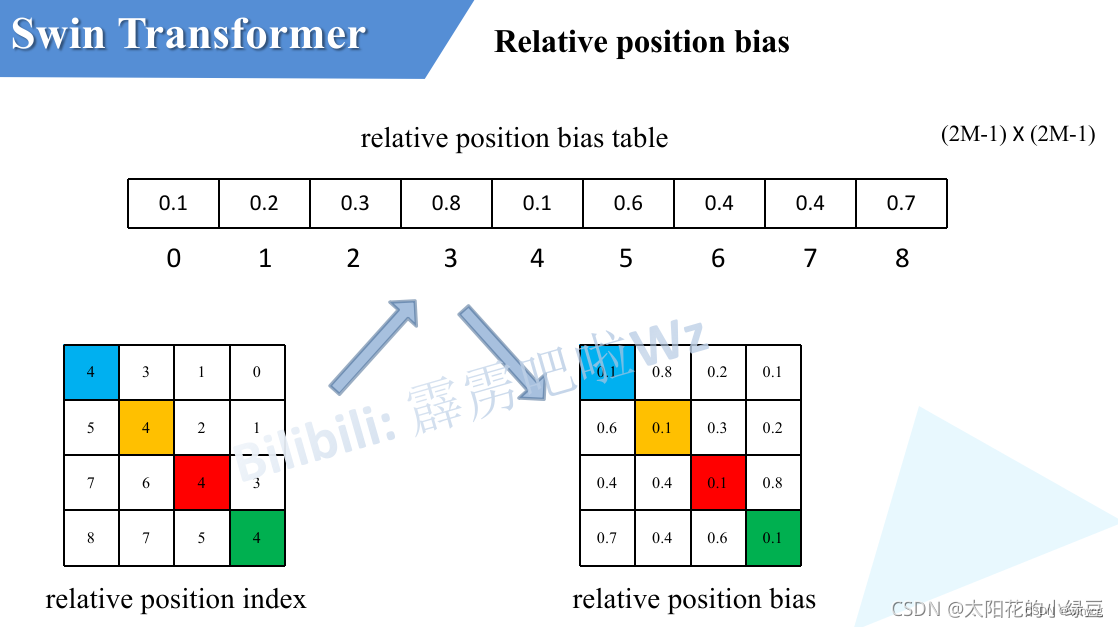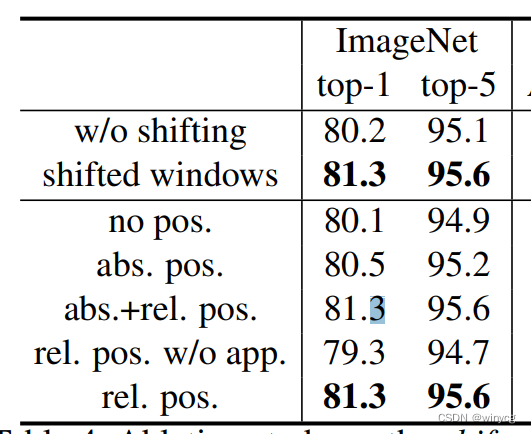-
vision transformer的位置编码总结
绝对位置编码
Vit采用绝对位置编码的形式,也就是使用一个值来表征每个patch的绝对位置,并且基于可学习的方式,一般的定义方式为:
absolute_pos_embed = nn.Parameter(torch.zeros(1, num_patches, embed_dim)) trunc_normal_(absolute_pos_embed, std=.02)- 1
- 2
将得到的position encoding直接加到输入的patch embedding就可以了:
x = x + self.absolute_pos_embed- 1
相对位置编码
Swin transformer中采用了相对位置编码的概念,考虑query和key的相对位置进行编码。
具体的详解参考:https://blog.csdn.net/qq_37541097/article/details/121119988这里的Relative Position Bias是加到self-attention的similarity矩阵计算的时候,而不是patch embedding,且在每层的self-attention计算时候都使用,具体的公式为:
A t t e n t i o n ( Q , K , V ) = S o f t M a x ( Q K T d + B ) V {\rm Attention}(Q,K,V)={\rm SoftMax}(\frac{QK^{T}}{\sqrt{d}}+B)V Attention(Q,K,V)=SoftMax(dQKT+B)V
这里 B B B是Relative Position Bias。如下图,假设输入的feature map高宽都为2,那么首先我们可以构建出每个像素的绝对位置(左下方的矩阵),对于每个像素的绝对位置是使用行号和列号表示的。比如蓝色的像素对应的是第0行第0列所以绝对位置索引是( 0 , 0 ) (0,0)(0,0),接下来再看看相对位置索引。首先看下蓝色的像素,在蓝色像素使用q与所有像素k进行匹配过程中,是以蓝色像素为参考点。然后用蓝色像素的绝对位置索引与其他位置索引进行相减,就得到其他位置相对蓝色像素的相对位置索引。例如黄色像素的绝对位置索引是( 0 , 1 ) (0,1)(0,1),则它相对蓝色像素的相对位置索引为( 0 , 0 ) − ( 0 , 1 ) = ( 0 , − 1 ) (0, 0) - (0, 1)=(0, -1)(0,0)−(0,1)=(0,−1),这里是严格按照源码中来讲的,请不要杠。那么同理可以得到其他位置相对蓝色像素的相对位置索引矩阵。同样,也能得到相对黄色,红色以及绿色像素的相对位置索引矩阵。接下来将每个相对位置索引矩阵按行展平,并拼接在一起可以得到下面的4x4矩阵 。

实现代码如下:>>> coords_h = torch.arange(2) >>> coords_w = torch.arange(2) >>> coords = torch.stack(torch.meshgrid([coords_h, coords_w])) # 2, Wh, Ww >>> coords_flatten = torch.flatten(coords, 1) # 2, Wh*Ww >>> coords_flatten tensor([[0, 0, 1, 1], [0, 1, 0, 1]]) >>> relative_coords = coords_flatten[:, :, None] - coords_flatten[:, None, :] # 2, Wh*Ww, Wh*Ww >>> relative_coords tensor([[[ 0, 0, -1, -1], [ 0, 0, -1, -1], [ 1, 1, 0, 0], [ 1, 1, 0, 0]], [[ 0, -1, 0, -1], [ 1, 0, 1, 0], [ 0, -1, 0, -1], [ 1, 0, 1, 0]]]) >>> relative_coords = relative_coords.permute(1, 2, 0).contiguous() # Wh*Ww, Wh*Ww, 2- 1
- 2
- 3
- 4
- 5
- 6
- 7
- 8
- 9
- 10
- 11
- 12
- 13
- 14
- 15
- 16
- 17
- 18
- 19
请注意,我这里描述的一直是相对位置索引,并不是相对位置偏执参数。因为后面我们会根据相对位置索引去取对应的参数。比如说黄色像素是在蓝色像素的右边,所以相对蓝色像素的相对位置索引为( 0 , − 1 ) (0, -1)(0,−1)。绿色像素是在红色像素的右边,所以相对红色像素的相对位置索引为( 0 , − 1 ) (0, -1)(0,−1)。可以发现这两者的相对位置索引都是( 0 , − 1 ) (0, -1)(0,−1),所以他们使用的相对位置偏执参数都是一样的。但在源码中作者为了方便把二维索引给转成了一维索引。由于索引的值范围为 [ − M + 1 , M − 1 ] [-M+1,M-1] [−M+1,M−1],原始的相对位置索引上加上 M − 1 M-1 M−1,使得索引的值大于等于0,变为 [ 0 , 2 M − 2 ] [0,2M-2] [0,2M−2]。

接着将所有的横坐标标都乘上 2 M − 1 2M-1 2M−1,方便之后横坐标和纵坐标求和之后的索引的独一性。

最后将行标和列标进行相加,得到独一的一维的索引。

>>> M=2 >>> relative_coords[:, :, 0] += M - 1 >>> relative_coords[:, :, 1] += M - 1 >>> relative_coords[:, :, 0] *= 2 * M - 1 >>> relative_position_index = relative_coords.sum(-1) >>> relative_position_index tensor([[4, 3, 1, 0], [5, 4, 2, 1], [7, 6, 4, 3], [8, 7, 5, 4]])- 1
- 2
- 3
- 4
- 5
- 6
- 7
- 8
- 9
- 10
之前计算的是相对位置索引,并不是相对位置偏执参数。真正使用到的可训练参数
是保存在relative position bias table表里的,这个表的长度是等于 ( 2 M − 1 ) × ( 2 M − 1 ) (2M-1)\times (2M-1) (2M−1)×(2M−1)的。那么上述公式中的相对位置偏执参数B是根据上面的相对位置索引表根据查relative position bias table表得到的,如下图所示。
Swin transformer的ablation study:

绝对编码 (absoluate position)能提升性能,但是效果不如相对编码(relative position),仅仅是相对编码的效果等价于相对编码+绝对编码 -
相关阅读:
Linux指令大全(文件和目录操作、文件内容查看和编辑、系统信息和管理、网络和通信、压缩和解压缩、权限管理、包管理……)
在SOLIDWORKS搭建一个简易的履带式机器人
除了SD Web UI 或comfyUI,还有更简单的运行SDXL的方法吗?
肽核酸(PNA)偶联穿膜肽(CCPs)(KFF)3K形成CCPs-PNA|肽核酸的使用方法
面试官:你说说 MySQL 索引失效有哪些场景?
2022-07-04 反省
快慢指针删除链表的第N个元素——力扣19
C++学习第四天(类与对象下)
C语言题解 | 移除元素(多种解法)
854. 相似度为 K 的字符串
- 原文地址:https://blog.csdn.net/winycg/article/details/127223017
